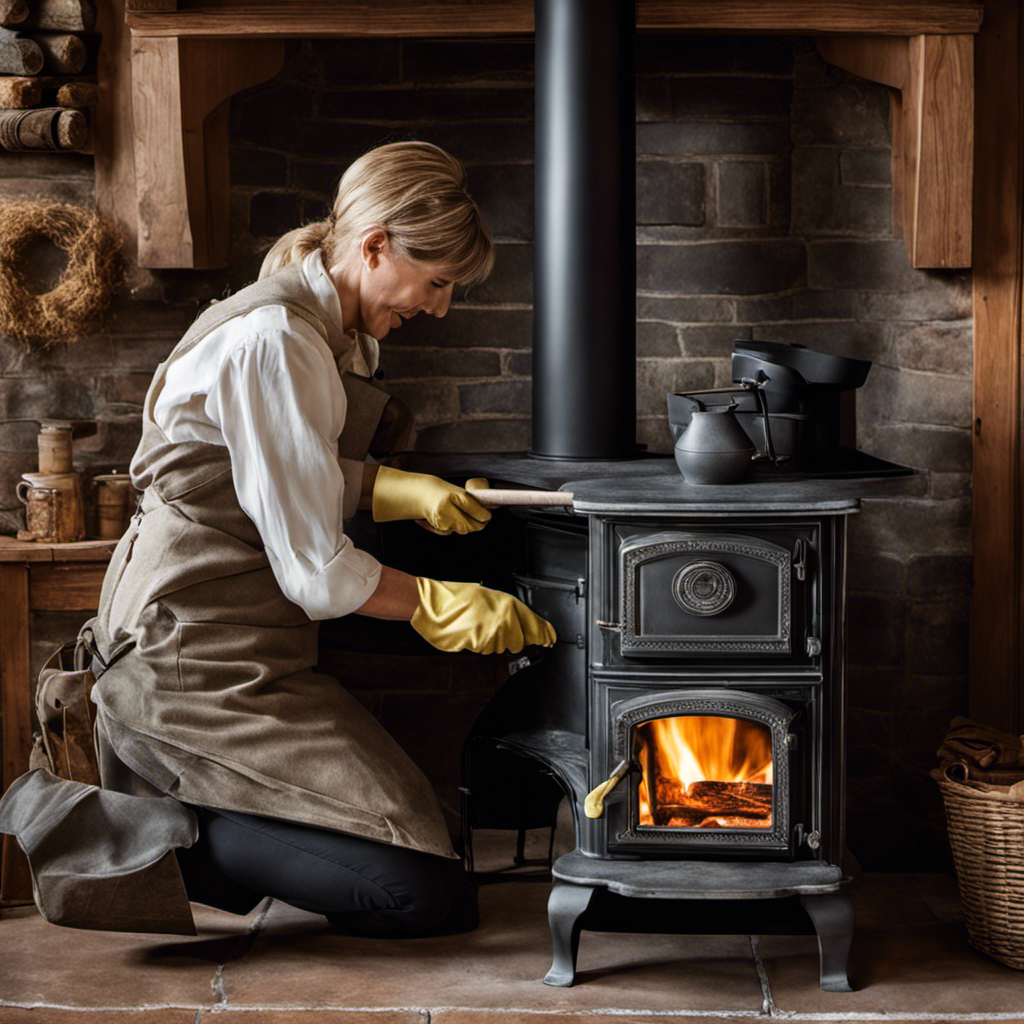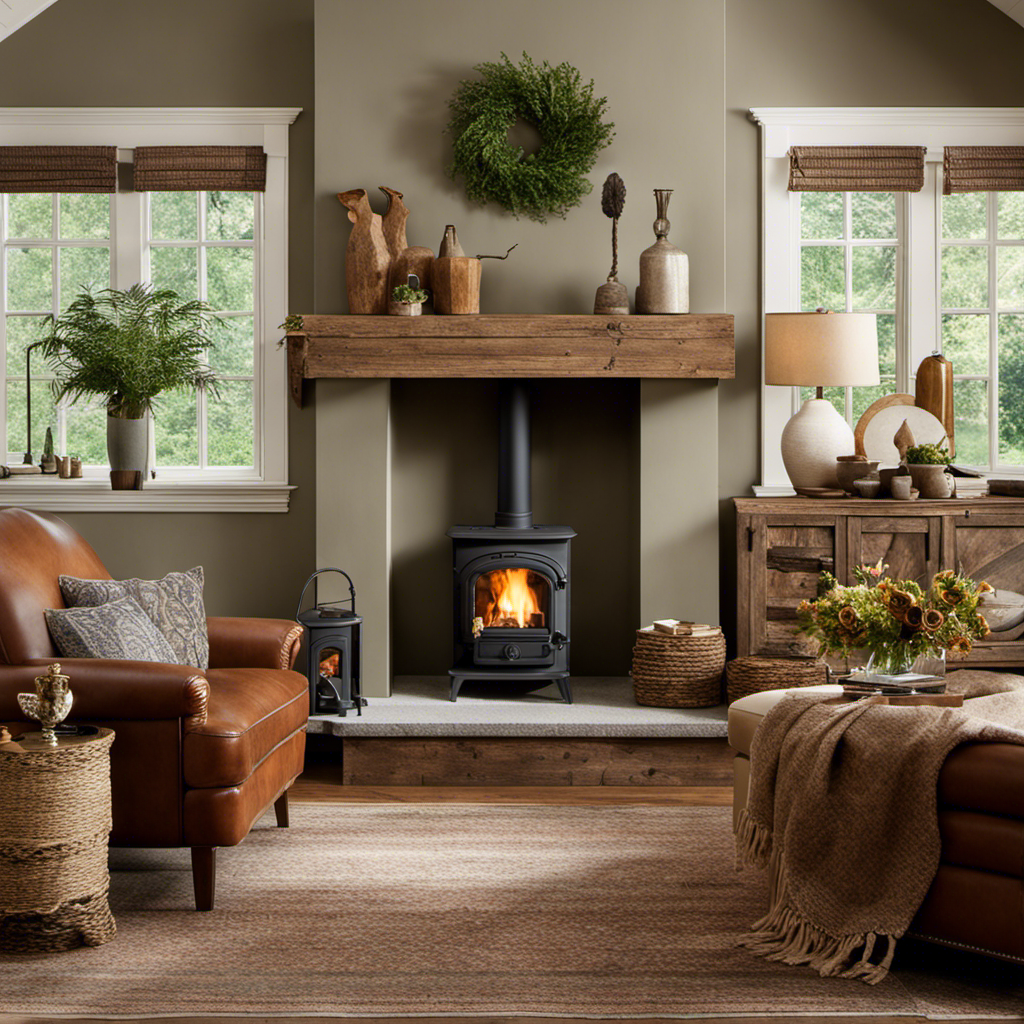Here’s a startling fact for you: every year, more than 25,000 home fires are caused by the accumulation of creosote in wood-stoves.
Scary, right? But don’t worry, because in this article, I’m going to show you exactly how to remove creosote from your wood stove.
With the right tools, materials, and a little elbow grease, you’ll be able to keep your home safe and your wood stove in top shape.
Let’s get started!
Key Takeaways
- Creosote buildup in wood stoves can cause chimney fires and is a common cause of house fires.
- Regularly removing creosote is crucial for maintaining wood stove safety.
- Mechanical cleaning with brushes and rods, chemical treatments, and professional chimney cleaning services are methods to remove creosote.
- Preventing future creosote buildup includes scheduling regular chimney inspections, burning seasoned firewood, using creosote prevention additives, and installing a chimney cap.
Understanding Creosote Buildup
I’ve noticed that creosote buildup is a common issue with wood stoves. Creosote is a black, sticky substance that forms when wood is burned incompletely. It’s highly flammable and can pose serious dangers if not addressed.
Creosote accumulation in the chimney can lead to chimney fires, which can cause extensive damage to your home and put your safety at risk. To prevent these dangers, it’s crucial to regularly remove creosote from your wood stove.
There are several methods to do this, including mechanical cleaning with brushes and rods, chemical treatments, and professional chimney cleaning services. By understanding the dangers of creosote accumulation and knowing the different removal methods available, you can effectively maintain your wood stove’s performance and safety.
Now, let’s move on to gathering the necessary tools and materials for the creosote removal process.
Gathering the Necessary Tools and Materials
To get started, I’ll need a bucket, a wire brush, and some protective gloves.
Cleaning creosote from a wood stove requires specific tools and materials, along with some safety precautions. The bucket will be used to collect the removed creosote, while the wire brush is essential for scrubbing off the buildup. Protective gloves are necessary to ensure your hands are shielded from any potentially harmful substances.
When using cleaning techniques for creosote removal, it’s important to follow safety guidelines. Make sure the wood stove is completely cool before beginning the cleaning process to avoid any burns. Additionally, ensure proper ventilation in the area to prevent inhaling harmful fumes.
Now that we’ve the necessary tools and safety precautions in place, let’s move on to preparing the wood stove for cleaning.
Preparing the Wood Stove for Cleaning
Before beginning the cleaning process, I’ll make sure the area around the wood stove is clear of any debris. This pre-cleaning inspection is essential to ensure a safe and effective cleaning experience.
To maintain safety while cleaning your wood stove, it’s important to take certain precautions:
- Wear protective gloves to prevent burns or skin irritation.
- Use a face mask to avoid inhaling harmful soot or dust particles.
- Keep a fire extinguisher nearby in case of any unexpected fire emergencies.
- Place a drop cloth or newspaper around the stove to catch any falling debris.
- Ensure proper ventilation by opening windows or doors to allow fresh air circulation.
Removing Creosote From the Chimney and Stove Pipes
While cleaning the chimney and stove pipes, I’ll ensure that I wear protective gloves and a face mask to keep myself safe from any harmful soot or dust particles.
To remove creosote from the chimney and stove pipes, there are a few effective methods you can try.
One option is to use a professional chimney sweep, who’ll have the necessary tools and expertise to properly clean the system. They may use mechanical brushes or high-pressure air to dislodge the creosote buildup.
Another option is to use cleaning solutions specifically designed for removing creosote. These solutions are applied to the inside of the chimney and pipes and left to sit for a period of time. Afterward, the creosote can be easily brushed off or rinsed away.
It’s important to follow the instructions on the cleaning solution carefully to ensure safe and effective removal of creosote.
Preventing Future Creosote Buildup
I can reduce the risk of future creosote buildup by regularly scheduling chimney inspections and cleanings. This will help ensure that my wood stove is operating efficiently and safely.
In addition to regular maintenance, there are several other creosote prevention methods that I can follow:
- Burning seasoned firewood: This helps reduce the amount of creosote produced.
- Using a creosote prevention additive: These products can help break down existing creosote and prevent new buildup.
- Installing a chimney cap: This prevents animals and debris from entering the chimney and potentially causing a blockage.
- Using the right wood stove size: Choosing a stove that’s properly sized for my space can help prevent creosote buildup.
- Following proper burning practices: This includes not overloading the stove and avoiding smoldering fires.
Frequently Asked Questions
How Long Does It Take for Creosote to Accumulate in a Wood Stove?
It takes time for creosote to accumulate in a wood stove. The accumulation rate depends on several factors, such as burning habits, wood type, and stove efficiency. Regular maintenance and cleaning are essential to prevent creosote buildup.
Can I Use Regular Household Cleaning Products to Remove Creosote From My Wood Stove?
Yes, you can use regular household cleaning products to remove creosote from your wood stove. However, it is important to take safety precautions and consider alternative methods for removing creosote to ensure effectiveness and protect your stove.
Is Creosote Removal Something I Can Do Myself, or Should I Hire a Professional?
Should I hire a professional or do it myself? I can save money and learn valuable skills by using self-cleaning methods or alternative removal techniques. But is it worth the risk?
Are There Any Health Risks Associated With Creosote Buildup in a Wood Stove?
There are health risks associated with creosote buildup in a wood stove. Breathing in creosote fumes can irritate the respiratory system and cause health problems. It is important to remove creosote regularly to maintain a safe and healthy environment.
How Often Should I Clean My Wood Stove to Prevent Creosote Buildup?
I clean my wood stove regularly to prevent creosote buildup. The best methods for removing creosote involve using a chimney brush and creosote remover. It’s important to clean the stove at least once a year to ensure safety and efficiency.
Conclusion
In conclusion, removing creosote from your wood stove is a necessary task to ensure safety and efficiency. By following the steps outlined in this article, you can effectively clean your chimney and stove pipes.
However, it’s important to note that despite your best efforts, creosote buildup may still occur in the future. So, stay vigilant and continue practicing regular maintenance to prevent any potential hazards.
After all, who doesn’t enjoy spending their weekends cleaning out a chimney?
Logan’s affair with adventure began in childhood. He hailed from a small town where vast forests bordered one side and endless shores stretched on the other. His days were spent exploring uncharted woods, climbing tall trees, or listening to the tales of old sailors. This early immersion in a world brimming with stories and mysteries became the foundation of his passion for writing.











